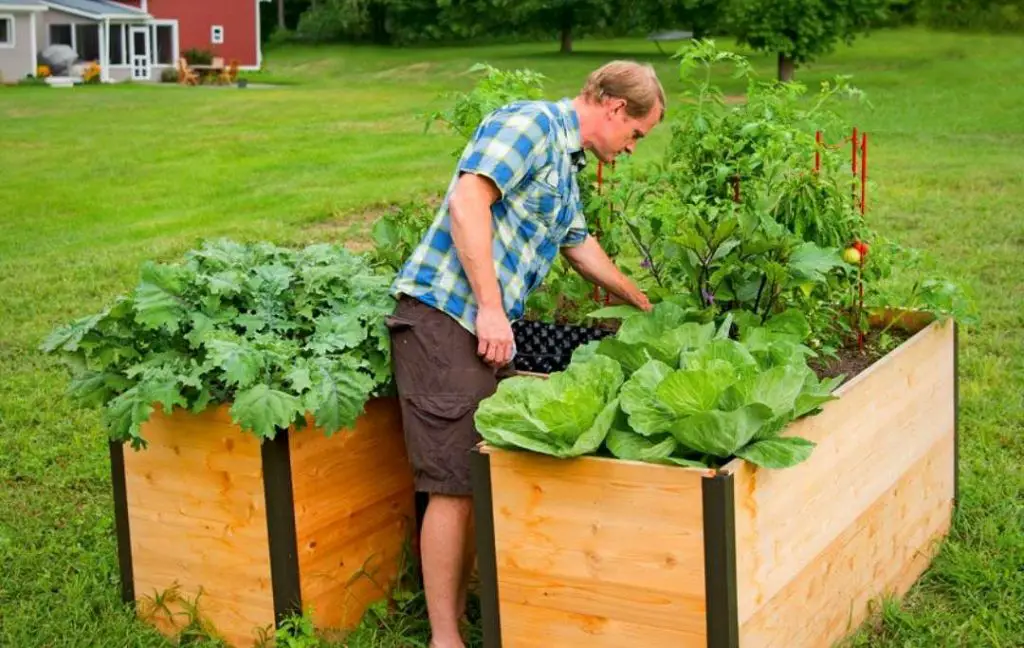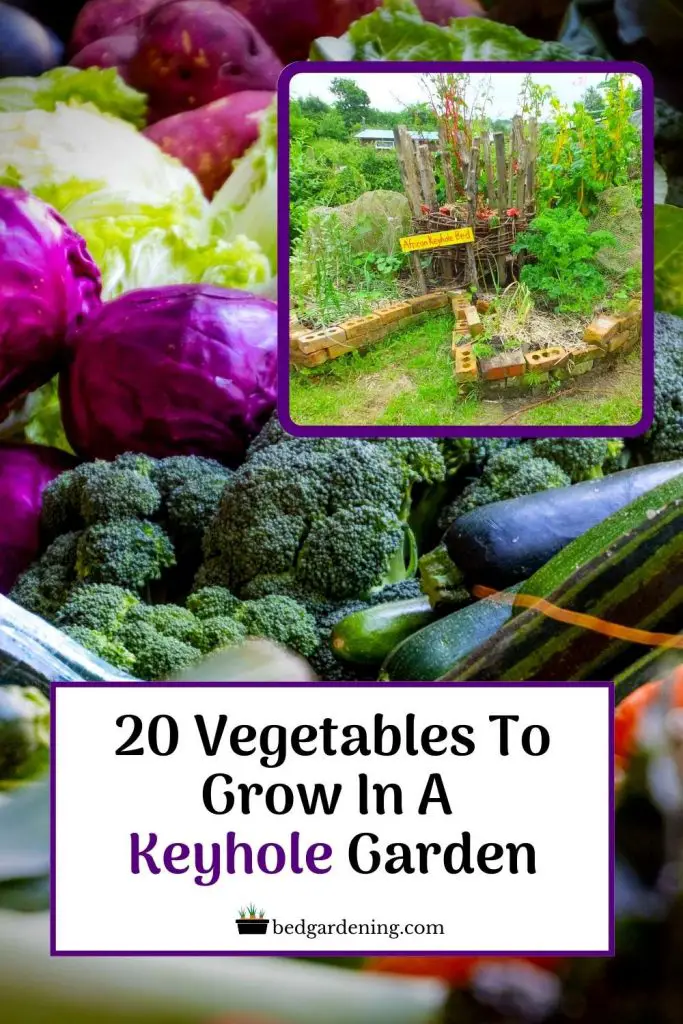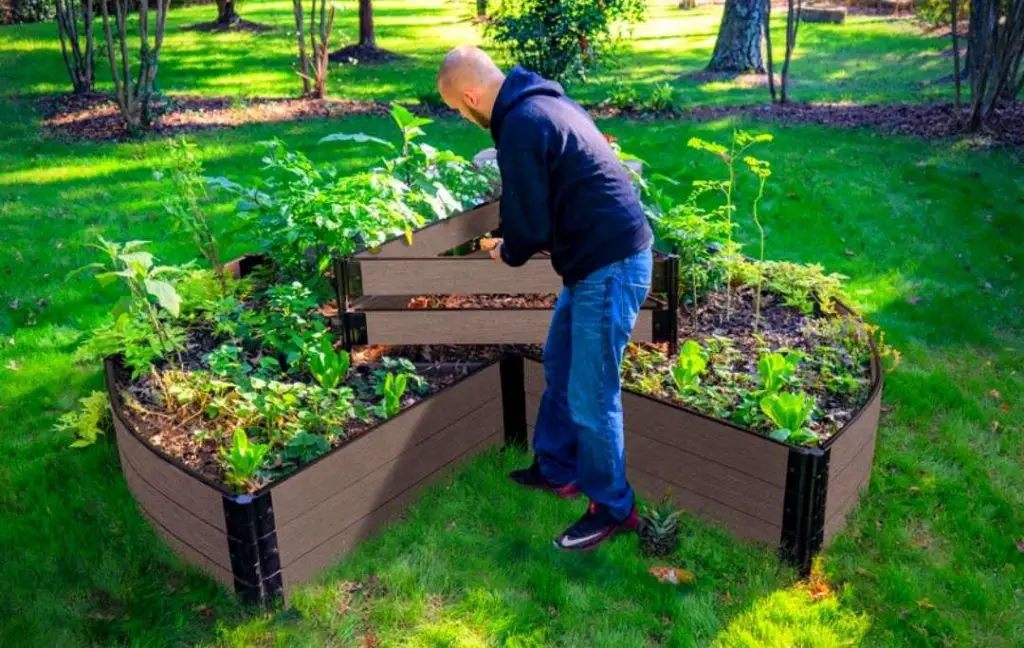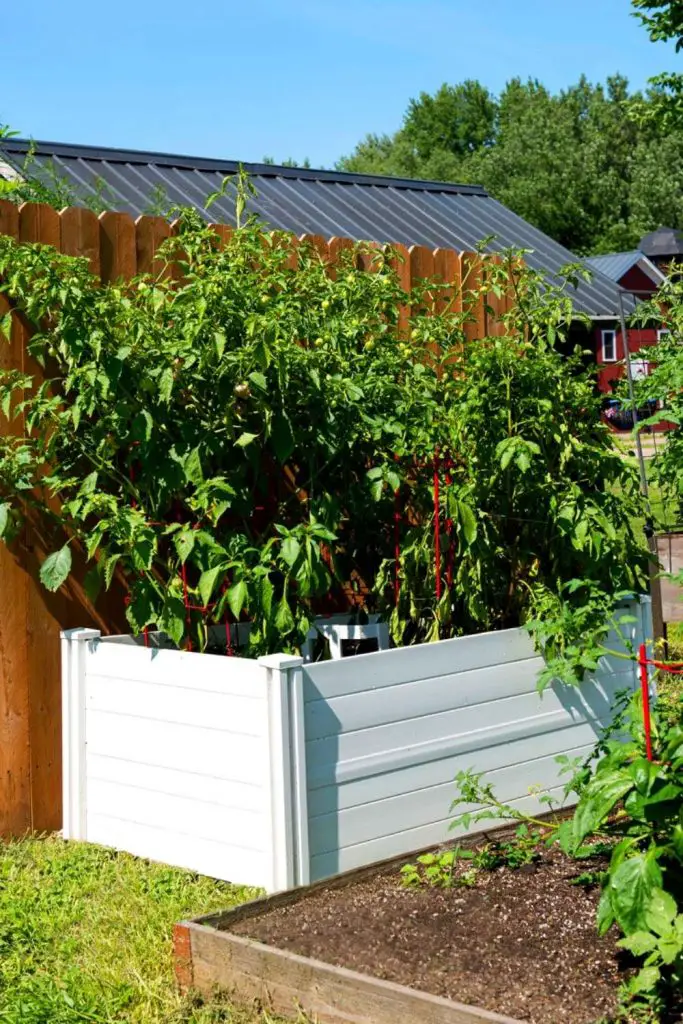The name keyhole garden is due to its shape. The shape of the keyhole garden is like an old-fashioned skeleton key lock. the concept of keyhole gardening first established in the 1990s for residents of Lesotho (South Africa). Afterward, this concept spread throughout the world.
This post may contain affiliate links and I may earn a small commission when you click on the links at no additional cost to you. As an Affiliate I earn from qualifying purchases.
WHAT IS A KEYHOLE GARDEN?

A keyhole garden is a circular raised garden bed that has a wedge-shaped cutout along one side. The shape of the keyhole garden allows access to the center plants of your extraordinary garden bed.
If you build a wide raised bed then you can’t look after your plants which are at the center of the bed. But the keyhole garden solved this problem.
This kind of garden is considered permaculture means permanent agriculture, the reason is that it is sustainable and regenerative. The best thing about this garden is that when you water it all the nutrients of compost spread in the soil.
This soil is highly nutritious that’s why there is no need of adding commercial fertilizer. As the garden is raised and promotes proper drainage. It means your soil remains moist which is good for your plant’s health.
WHAT TO GROW IN KEYHOLE GARDEN?
After building your keyhole garden you will start thinking about which vegetables you can grow easily. Now we are going to explain 20 vegetables which you can grow effortlessly in this circular bed.
1- ONIONS
Onions are perfect vegetables for growing in a keyhole garden. Well-drained soil and organic matter are best for their germination. You can maintain the fertility of the soil in a keyhole garden.
You can add compost to the soil to provide all the basic nutrients to your soil. Onions can mature in 100 days. As you know the soil in the keyhole garden warms up quickly so it is very easy for you to plant earlier.
2- TOMATOES
You can easily maintain nutrients in the soil when you grow vegetables in a keyhole garden. Tomatoes are unique vegetables that are heavy feeders. After the spring frost, you can easily grow tomatoes in the keyhole garden.
3- POTATOES
Harvesting potatoes become very easy in raised beds. Potatoes like loose, loamy, and well-drained soil. The loose soil keeps potatoes from rotting.
The major benefit of a keyhole garden is that you have complete control over the soil. If you grow potatoes in the keyhole garden then you will get higher production of this crop.
4- BUSH BEANS
Bush beans like warm soil, they also prefer warm weather to grow well. It means you should not plan to plant beans early in spring. Try to sow the seeds in rows spaced 18 inches apart.
There are different varieties of Bush beans available. You can also grow a rainbow of beans. you love to plant a mixture of green, yellow, green, and even red varieties.
Beans are a great addition to your garden. You can get iron, fiber, manganese, and phosphorus from them. The best time to harvest beans is when the pods are dried on the vine. The color of the pods should be light brown and you can store them in a jar but place them in a cool dry place.
5- PEAS
The famous varieties of these are snow peas, sugar peas, and shell peas. You can easily grow all these varieties in a keyhole garden. The best time for sowing the seeds is in the early spring season. Loose and rich soil is needed for the good health of your pea plants.
The gap between rows should be 6 inches. It is important to know that pea plants need support so you should install a trellis to give proper support for better development. If you train your pea plants on a trellis so you can easily maintain them, harvesting will become very easy.
6- SUMMER SQUASH
You can easily grow squashes from the seed. your soil needs a proper amount of compost or manure. The best time for planting squash is after the last spring frost.
If you harvest them on time then you will get good flavor and quality of squash. There are a lot of varieties of summer squash for your garden. The best type of squash for your bed is Patio Green Bush or Astia.
7- CUCUMBER
The vegetables you get from your keyhole garden are fresher than from the store. As you know cucumber is a warm-season vegetable. You can directly grow them from seeds in garden beds or containers.
The best time for planting cucumbers is after the last spring frost. Make sure your cucumber plant gets water regularly. Consistent water and plenty of compost needed for high-quality cucumbers.
8- GARLIC
Garlic is very easy to grow plants because it needs little maintenance. The garlic which you grow at home is free from chemicals. After planting the garlic in a keyhole garden. You need to mulch your keyhole garden with straws to hold soil moisture.
The best time for harvesting garlic is when the leaves become yellowed. After that hang the plants to cure in a dry spot. After 2 weeks of curing, clean the bulbs and store them.
9- LEAF LETTUCE
If you are looking for a vegetable which can fast grow in your keyhole garden then leaf lettuce is a good option for you. You can easily grow them from seeds.
The interesting thing is that you can clip leaves from the outside of the plant and the center will continue to grow. There are dozens of leaf lettuce varieties such as Red Salad Bowl, Red Sails, Lollo Rossa, and Black Seeded Simpson. Lettuce will add flavor to your favorite dishes. It is the basic ingredient of salad.
10- RADISHES
Radish is such a vegetable which can easily grow. So if you are a newbie in gardening then this crop is best for you. After a few weeks of sowing, you will see rosy-red radishes.
You can sow seeds at regular intervals from March to mid-August. In this way, you will get a constant supply of radishes.
11- CARROTS
If the soil in the garden is compacted or stony then this is the best idea to grow veggies in a keyhole garden. This is the best way to maintain the growing medium for your plants. You can sow seeds of carrots from April to early July and harvest them after a couple of months.

12- BEETROOT
Beetroot grows fast if you compost your bed in early April. Try to keep your soil moist, for this purpose make sure your plant’s regular water. You can sow beetroot seeds at two weekly intervals and you will get beetroot over several months.
13- BROCCOLI
Avoid growing your broccoli crop too closely in the keyhole garden. Broccoli likes loose, rich, acidic, and well-drained soil. It needs regular fertilizer as broccoli is a heavy feeder. Cabbage loopers are common pests which is a problem for broccoli plants.
Make sure your broccoli plant gets consistent and regular water but avoid overwatering because it does not like wet feet. The Important factor in the growth of plants is sunlight. Broccoli needs 6 hours of sunlight daily and the suitable temperature for its growth is above 80 °F.
14- ZUCCHINI
Zucchini don’t like cold temperatures so it means that you can’t grow them in cold weather so avoid planting them in frost. You should plant it in the middle of Spring. The temperature should be above 60 degrees Fahrenheit.
But if the temperature falls below 60 degrees Fahrenheit then you cover your crop to protect them from harsh weather. The important thing about zucchini is that it is a fast grower.
You will get fruit within 50 to 60 days. You can easily grow zucchini from seeds, the germination process is completed within days.
15- CAULIFLOWER
Manure is the best treatment for cauliflower plants. Cauliflower can grow in spring and fall. You can say it is a temperamental plant because it can’t tolerate heat or cold.
Cauliflower comes in different colors like purple, yellow, and orange. This plant needs rich soil so you should add compost into your keyhole garden. You can add mulch to maintain the moisture of the soil.
You should add water regularly so your plants will not dry. The time to harvest comes when the heads become compact, firm, and white. You should cut the head with a knife. You can store the heads in a plastic bag and keep this bag in the refrigerator and can be last a week.
16- KALE
You can plant kale in early spring or late summer. Kale belongs to the brassica families such as cabbage, broccoli, and Brussels sprouts. Make sure your kale plant gets full sunlight. It likes well-drained and rich soil.
If you want to increase the richness of the soil, you can add compost or blood meal. Water the plant regularly and mulch the soil. You can get yield throughout the winter.
When the size of kale is equal to your hand it means your plant is ready for harvest. The leaves of kale can be eaten uncooked. For one week you can store them in the refrigerator.
17- ARUGULA
This veggie is fast-growing and makes your salad tasty, it gives mustered like flavor. You can harvest arugula within 4 weeks after sowing. The seedlings of this plant are very hardy and can tolerate frost.
Arugula likes rich and well-drained soil, it can tolerate severe conditions of weather. Make sure, your soil should be moist, for this purpose, water your plants regularly.
There are different varieties of this veggie such as Runway, Garden, Italian Rocket, and Astro. If your plant gets full Sun then it will be developed properly.
The best time for planting arugula is in late summer or early winter. The germination process of this plant will be completed in a few days. If you want continuous harvest you can so new seeds after every 2 to 3 weeks. In the warm season, it needs some shade.
18- TURNIPS
Turnips like cool weather so you can easily grow them in spring and fall, but avoid summer months it can’t tolerate hot weather. They are a fast-growing crop and you can get both the green and the roots from them.
You can directly sow the turnip seeds in your garden. If you sow turnip in late summer, you will get an autumn harvest. This crop needs full sun and well-drained soil. If you want to increase the fertility of the soil you can add compost or exit manure in it.
19- BRUSSELS SPROUTS
Overcooking is not good for the brussels sprouts. If you cook them properly then you will get a sweet and tender taste. Brussels sprouts are a good source of magnesium, potassium, and vitamins.
They need fertile soil with plenty of compost and manure. The best time for planting Brussels sprouts is from mid-March to early May. The harvesting period is very long for this veggie, it starts in September and ends in February.
In dry weather, keep your sprouts moist with water as they prefer moist soil. This crop is a heavy feeder, it needs nitrogen so you can add seaweed-chicken manure which is a good source of nitrogen. Liquid seaweed feed is also so good option for this purpose.
20- RED BELL PEPPERS
Bell peppers like the warm season, for planting them wait for the temperature of your region rise to 50 degrees Fahrenheit r 10-degree centigrade. There should be no danger of frost when you are planting the bell peppers.
The size of the paper is about 3 to 4 inches, which means your veggie is ready to harvest. Red bell peppers are a good source of potassium and vitamins.
You should be careful of aphids and flea beetles because they are common pests that attack this plant. But some useful remedies help to fight this problem. Insecticidal soap is a good solution to such issues.


